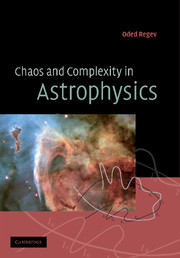Book contents
- Frontmatter
- Contents
- Preface
- Acknowledgements
- Part I Dynamical systems – general
- Part II Astrophysical applications
- 8 Introduction to Part II
- 9 Planetary, stellar and galactic dynamics
- 10 Irregularly variable astronomical point sources
- 11 Complex spatial patterns in astrophysics
- 12 Topics in astrophysical fluid dynamics
- References
- Index
9 - Planetary, stellar and galactic dynamics
Published online by Cambridge University Press: 14 January 2010
- Frontmatter
- Contents
- Preface
- Acknowledgements
- Part I Dynamical systems – general
- Part II Astrophysical applications
- 8 Introduction to Part II
- 9 Planetary, stellar and galactic dynamics
- 10 Irregularly variable astronomical point sources
- 11 Complex spatial patterns in astrophysics
- 12 Topics in astrophysical fluid dynamics
- References
- Index
Summary
She: Have you heard it's in the stars,
Next July we collide with Mars?
He: Well, did you evah!
What a swell party this is.
Cole Porter, Well, Did You Evah?Poincaré's important (and surprising) discovery that classical Hamiltonian systems, the paradigm of determinism, may be non-integrable and exhibit a seemingly erratic behaviour, had its roots in one of the most fundamental astronomical problems. In his book, entitled New Methods in Celestial Mechanics, Poincaré laid the basis for a geometrical approach to differential equations and made a number of significant mathematical discoveries. One of the consequences of these findings, phrased in a language that is relevant to us here, is that the gravitational n-body problem is generally non-integrable already for n = 3. We shall start this chapter with a short historical note on this subject.
Beyond their historical significance, Poincaré's findings have obvious relevance to astrophysics, as some of the most basic astronomical systems are naturally modelled by a number of mutually attracting point masses. For example, the Sun–Earth–Moon system can be viewed as a three-body problem, and its investigation was actually the initial motivation for Poincaré's work. The dynamics of the constituents of the Solar System (another obvious example of the n-body problem), and the question of the stability of this system as a whole, have always naturally enjoyed widespread attention. The masses of the objects in this system are very unequal and it is only natural to neglect the very minor planets, the planet moons and other small bodies if one is interested in the dynamics of the major planets. One is thus left with 3 < n < 6, say.
- Type
- Chapter
- Information
- Chaos and Complexity in Astrophysics , pp. 260 - 316Publisher: Cambridge University PressPrint publication year: 2006



